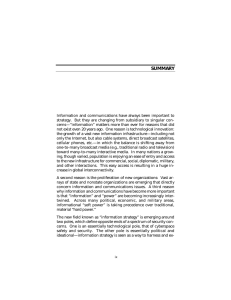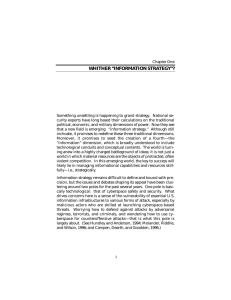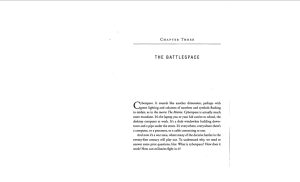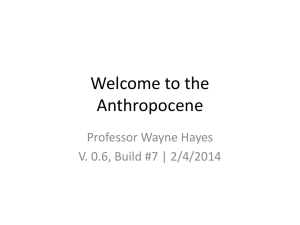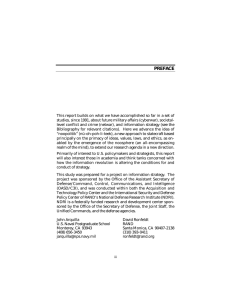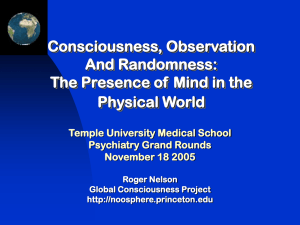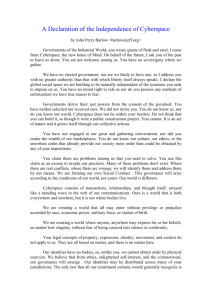RECOGNITION OF THE NOOSPHERE WHY “INFORMATION” MATTERS
advertisement
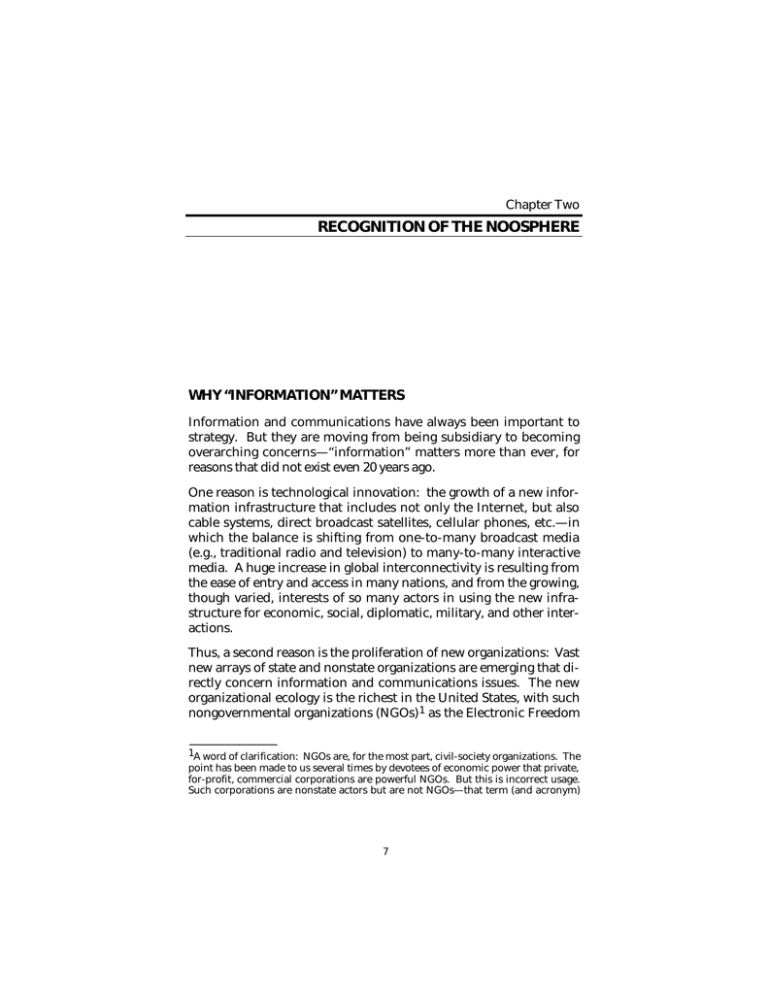
Chapter Two RECOGNITION OF THE NOOSPHERE WHY “INFORMATION” MATTERS Information and communications have always been important to strategy. But they are moving from being subsidiary to becoming overarching concerns—“information” matters more than ever, for reasons that did not exist even 20 years ago. One reason is technological innovation: the growth of a new information infrastructure that includes not only the Internet, but also cable systems, direct broadcast satellites, cellular phones, etc.—in which the balance is shifting from one-to-many broadcast media (e.g., traditional radio and television) to many-to-many interactive media. A huge increase in global interconnectivity is resulting from the ease of entry and access in many nations, and from the growing, though varied, interests of so many actors in using the new infrastructure for economic, social, diplomatic, military, and other interactions. Thus, a second reason is the proliferation of new organizations: Vast new arrays of state and nonstate organizations are emerging that directly concern information and communications issues. The new organizational ecology is the richest in the United States, with such nongovernmental organizations (NGOs) 1 as the Electronic Freedom ______________ 1A word of clarification: NGOs are, for the most part, civil-society organizations. The point has been made to us several times by devotees of economic power that private, for-profit, commercial corporations are powerful NGOs. But this is incorrect usage. Such corporations are nonstate actors but are not NGOs—that term (and acronym) 7 8 The Emergence of Noopolitik: Toward an American Information Strategy Foundation (EFF) and Computer Professionals for Social Responsibility (CPSR) exemplifying the trend. These groups span the political spectrum and have objectives that range from helping people get connected to the Internet, to influencing government policies and laws, and advancing particular causes at home or abroad. It is not just the proliferation of such organizations, but also their interconnection in sprawling networks that makes them increasingly influential. As the strength of NGOs in particular and nonstate actors in general grows, the nature of world politics promises to become less state-centric. A third reason is ideational: a spreading recognition that “information” and “power” are increasingly intertwined. Across all political, economic, and military areas, informational soft power (Nye, 1990; Nye and Owens, 1996) is becoming more important, compared to traditional hard power. This trend may take decades to unfold; in the interim, traditional methods of exercising power may remain squarely at the core of international politics. But meanwhile, the rise of soft power provides another reason for attending to the formulation of information strategy—power, security, and strategy are increasingly up for redefinition in the information age. At all three levels—the technological, organizational, and ideational—“network effects” are taking hold, further helping explain why information is influencing more than ever people’s behavior as well as government policies and strategies. Network effects mean, for example, that if only one person has a telephone or fax machine, it is not useful—he or she cannot communicate with anyone else. But as more people use phones and faxes, the value of each one increases, as does the value of the network as a whole.2 According to “Metcalfe’s law” (named after Robert Metcalfe, who designed the communication protocol governing the Ethernet), the “power” of a network is proportional to the square of the number of nodes in it. ______________________________________________________________ apparently dates from the early years of the United Nations and was not meant to include commercial corporations. Neither was a related term, international nongovernmental organization (INGO), which we do not use here. 2The network effect involves not only expansion of a network but also standardization to ease access to it. Oft-cited stories about network effects explain, for example, why the VHS format prevailed over Beta in videocassette recorder technology, even though Beta was considered a superior technology. Recognition of the Noosphere 9 Network effects may apply to the spread of not only new technologies, but also new organizations and ideas. Together, these technological, organizational, and ideational developments mean that information is increasingly viewed as an agent of system change and transformation. They also mean that information-based realms are being created that thrive on network effects. THREE CONCEPTS OF INFORMATION-BASED REALMS3 As information and communication have come to matter more, so have the realms or domains defined by them. The three that matter the most are cyberspace, the infosphere, and the noosphere.4 All are about information, and all combine technological, organizational, and ideational elements. But each has a different focus and emphasis—and this affects their significance for strategy. They are discussed below in a progression, from the most technological (cyberspace), to the most ideational (the noosphere). Analysts, strategists, and policymakers face choices as to which term(s) to prefer. The term noosphere may be difficult to adopt—it sounds weird. But recall that the term cyberspace was initially received this way—yet now it is routine. The term infosphere has never been so controversial; and, for many people, it may look like a goodenough term of art. However, it, like the other terms, has some inherent biases and limitations that should give pause, as noted below. Meanwhile, some people may prefer to cast aside all three terms, in favor of just referring to a “realm of information,” much as people ______________ 3Some of the writing in this section is repeated from Ronfeldt (1992). 4Dertouzos (1997) proposes another concept—the Information Marketplace—which means (p. 10) the collection of people, computers, communications, software, and services that will be engaged in the intraorganizational and interpersonal information transactions of the future. In his view (p. 12), “the Information Marketplace—not Cyberspace—is the target toward which the Internet and the Web are headed.” His concept is a variant of the infosphere, with an emphasis on economic motivations and transactions. But it has a noospheric element—he hopes for a coming “Age of Unification” in which the “techiehumie split” is resolved and a new agenda for humanism is served. 10 The Emergence of Noopolitik: Toward an American Information Strategy have long referred to the realms of politics, economics, and security. Eventually, that may make sense. However, in our view, it is too early to do that as a matter of course; the notion of a “realm of information” remains too overarching and all-inclusive, too shapeless and unbounded, to provide a sound basis for strategy. For the time being, it is more advisable to clarify and make better use of the concepts of cyberspace, the infosphere, and the noosphere. Cyberspace This, the most common of the three terms, refers to the global system of systems of internetted computers, communications infrastructures, online conferencing entities, databases, and information utilities generally known as the Net. This mostly means the Internet; but the term may also be used to refer to the specific, bounded electronic information environment of a corporation or of a military, government, or other organization. The term serves to envision the electronic stocks and flows of information, the logged-in providers and users of that information, and the technologies linking them as a realm or system that has an identity as distinct as that of an economic or political system. Ideally, as technology advances, a user should be able to access and operate in cyberspace through hardware and software that render the impression of being inside a three-dimensional environment containing representations of the places, actors, instruments, and repositories that a user is interested in. Cyberspace is the fastest growing, newest domain of power and property in the world. The Internet alone now embraces some 20 million computer hosts, nearly a hundred million users (expected to exceed a billion by the year 2000), and billions if not trillions of dollars’ worth of activities. Further developing this realm, nationally and globally, is one of the great undertakings of our time. No wonder the term has gained such currency. The term has a more technological bent than infosphere or noosphere. Yet, there has always been a tendency to see cyberspace as far more than technology, from the moment the term was proposed by cyberpunk writer William Gibson (1984) as a “consensual hallucination,” through recent notions of cyberspace as a realm for building Recognition of the Noosphere 11 “virtual communities” (Rheingold, 1993), creating a “global matrix of minds” (Quarterman, 1990 and 1993), and strengthening people’s spiritual bonds around the world (Cobb, 1998). Such views implicitly portend an overlap of cyberspace with the noosphere (see below). Cyberspace is more bounded than the infosphere or the noosphere, in that it refers mainly to the Net. But some definitions extend beyond the Internet to include the public switched networks (PSNs) and other cyberspace access points and controls for affecting critical infrastructures: e.g., electric power grids, oil and gas pipelines, telecommunications systems, financial clearinghouses, air traffic control systems, railroad switching systems, truck location and dispatch systems, media broadcast systems, and military and other government security systems. Strategic information warfare is largely about assuring cyberspace security and safety at home, and developing a capacity to exploit vulnerabilities in systems abroad. Infosphere Knowing the spatial and technical limitations of the cyberspace concept, some analysts prefer the term infosphere. Sometimes the two terms are used interchangeably, or the distinctions between them are unclear. For example, in one recent view (Vlahos, 1998, p. 512), The Infosphere is shorthand for the fusion of all the world’s communications networks, databases, and sources of information into a vast, intertwined and heterogeneous tapestry of electronic interchange. . . . The Infosphere has the potential to gather all people and all knowledge together into one place. This could as easily be a definition of cyberspace in some quarters. But, when defined distinctly, the infosphere is far larger than cyberspace—it encompasses the latter, plus a range of information systems that may not be part of the Net. In the civilian world, this often includes broadcast, print, and other media (i.e., the mediasphere), as well as institutions, such as public libraries, parts of which are not yet electronic. In the military world, the infosphere may include command, control, communications, intelligence, surveillance, and reconnaissance systems—the electronic systems of the “military in- 12 The Emergence of Noopolitik: Toward an American Information Strategy formation environment” (another term of art) above and around a battlespace. According to Jeffrey Cooper (1997, pp. iii, 3, 27), the infosphere is emerging, like cyberspace, as a “truly global information infrastructure and environment” in which traditional notions of space and time no longer prevail. The term has merit because it focuses on “information environments,” broadly defined, rather than on computerized technologies and infrastructures. The term is also favored because it “carries resonances of biosphere”—meaning that the infosphere is “a distinct domain built on information, but one intimately related to the rest of a set of nested globes in which we exist simultaneously.” In observing this, Jeffrey Cooper implicitly entertains a view of the world that partakes of the next concept. So does French philosopher Paul Virilio in the following insight from an interview with James der Derian (1996): I think that the infosphere—the sphere of information—is going to impose itself on the geosphere. We are going to be living in a reduced world. The capacity of interactivity is going to reduce the world to nearly nothing. In fact, there is already a speed pollution, which reduces the world to nothing. In the near future, people will feel enclosed in a small environment. They will have a feeling of confinement in the world, which will certainly be at the limit of tolerability, by virtue of the speed of information. If I were to offer you a last thought—interactivity is to real space what radioactivity is to the atmosphere. Noosphere The most abstract—and so far, least favored—of the available terms is that of the noosphere. This term, from the Greek word noos for “the mind,” was coined by the controversial French theologian and scientist Pierre Teilhard de Chardin in 1925 and disseminated in posthumous publications in the 1950s and 1960s.5 In his view, the ______________ 5Teilhard’s belief in the need for an expansive, ethically based noosphere may have been based partly on his grim experiences during World War I, which are movingly chronicled in his correspondence from this period (Teilhard, 1961). Recognition of the Noosphere 13 world first evolved a geosphere and next a biosphere. Now that people are communing on global scales, the world is giving rise to a noosphere—what he variously describes (1964 and 1965) as a globespanning realm of “the mind,” a “thinking circuit,” a “stupendous thinking machine,” a “thinking envelope” full of fibers and networks, and a planetary “consciousness.” In the words of Julian Huxley (in Teilhard, 1965, p. 18), the noosphere amounts to a “web of living thought.” According to Teilhard, forces of the mind have been creating and deploying pieces of the noosphere for ages. Now, it is finally achieving a global presence, and its varied “compartments” are fusing. Before long, a synthesis will occur in which peoples of different nations, races, and cultures will develop consciousness and mental activity that are planetary in scope, without losing their personal identities. Fully realized, the noosphere will raise mankind to a high, new evolutionary plane, one driven by a collective coordination of psychosocial and spiritual energies and by a devotion to moral and juridical principles. However, the transition may not be smooth; a global tremor and possibly an apocalypse may characterize the final fusion of the noosphere (1964, pp. 175–181; 1965, pp. 287–290). Although this concept is essentially spiritual, and far less technological than cyberspace or the infosphere, Teilhard identified increased communications as a cause. Nothing like the Internet existed in his time. Yet 1950s-era radio and television systems were fostering the emergence of “a sort of ‘etherized’ universal consciousness,” and he expected “astonishing electronic computers” to give mankind new tools for thinking (1964). Today, he is occasionally credited with anticipating the Internet. Indeed, the gestalt of Wired magazine evokes the creed that “an electronic membrane covering the earth would wire all humanity together in a single nervous system,” giving rise to a global consciousness (from Wired, Vol. 6, No. 1, January 1998; also see Cobb, 1995). John Perry Barlow, a frequent Wired contributor and a cofounder of the Electronic Freedom Foundation, observes (in Cobb, 1998, p. 85) that [w]hat Teilhard was saying can be summed up in a few words. The point of all evolution to this stage is to create a collective organism of mind. With cyberspace, we are essentially hardwiring the noosphere. 14 The Emergence of Noopolitik: Toward an American Information Strategy Furthermore, Teilhard voiced, decades ago, many notions now in favor among information-age thinkers about complexity, the association of complexity with consciousness, and the shift from genes to what he called “noogenesis” (a vehicle for memes?6) as a basis of future human evolution. His view of planetary society as a “superorganism” helped inspire Marshall McLuhan’s notion of the “global village” and James Lovelock’s and Lynn Margulis’s “Gaia thesis” (which, in turn, influenced Vice President Albert Gore’s ideas about keeping the Earth’s environment in balance). The noosphere concept thus encompasses cyberspace and the infosphere and has its own technological, organizational, and ideational levels. It relates to an organizational theme that has constantly figured in our own work about the information revolution: the rise of network forms of organization that strengthen civil-society actors (Arquilla and Ronfeldt, 1996a, 1997; Ronfeldt, 1996). Few state or market actors, by themselves, seem likely to have much interest in fostering the construction of a global noosphere, except in limited areas having to do with international law, or political and economic ideology. The impetus for creating a global noosphere is more likely to emanate from activist NGOs, other civil-society actors (e.g., churches and schools), and private individuals dedicated to freedom of information and communications and to the spread of ethical values and norms. 7 Testimony for this comes from Elise Boulding, a scholar-activist who has long worked in peace networks. She sees, à la Teilhard, a “manylayered map of the world” consisting of the geosphere, biosphere, and what she calls the “sociosphere,” which includes families, communities, nation-states, international organizations, and “the peoples’ layer—the transnational network of international voluntary organizations” (Boulding, 1988, pp. 54–55). Atop that is the noosphere, ______________ 6Dawkins (1989) originated the notion of “memes” as a postgenetic basis for continued human evolution. Lynch (1996) discusses how memes may spread through “thought contagion.” 7For a novel discussion that actually relies on the concept of the noosphere—arguing that open-source software is an expression of a gift-culture among hackers working in the noosphere, defined as “the territory of ideas, the space of all possible thoughts”— see Eric S. Raymond, Homesteading the Noosphere, April 1998, posted at http://www.tuxedo.org/~esr/writings/. Recognition of the Noosphere 15 which consists of “the sum total of all the thoughts generated in the sociosphere.” In her view, [t]he more we can involve ourselves in the networks that give us access to that envelope, the more we can contribute to the emergence of that [global civic] culture. Her hope is that globe-circling associations of private citizens will foster a “global civic culture” based on the notion that people of various nationalities have common interests. NGOs and other groupings of ethically minded individuals, energized by a noospheric culture, could alter how the world is governed (Boulding, 1988 and 1993). Boulding’s writings, in addition to others’ (e.g., Frederick, 1993a and b), indicate that the noosphere concept has gained more resonance and credibility among transnational civil-society actors than among government and commercial actors. We believe it is time for the latter to begin moving in this direction, too, particularly since power in the information age will stem, more than ever before, from the ability of state and market actors to work conjointly with civil-society actors. COMPARISONS LEAD TO A PREFERENCE FOR THE NOOSPHERE CONCEPT All three realms are under development and will remain so. Even though all are expanding rapidly around the world, they are still split into compartments, which are more advanced in some parts of the world than in others. A steady internetting of their varied compartments is under way (although a total worldwide fusion seems unlikely, if only because of some actors’ interests in protecting partitions in some areas). But even as the three realms grow, they will continue to overlap. Cyberspace will remain the smallest, nested inside the other two. The infosphere is the next largest, and the noosphere encompasses all three (see the Figure). As one realm grows, so should the others—although not necessarily evenly. None of the three concepts should be dismissed—all are useful. But their biases should be recognized. The realms all have technological, 16 The Emergence of Noopolitik: Toward an American Information Strategy RAND MR1033 Noosphere Infosphere Cyberspace Figure—Three Realms of Information organizational, and ideational levels; but these levels, and their significance, are somewhat different for each. Moreover, each has an inherent image that may affect how a person thinks about each.8 Of the three, the core image for cyberspace is the most technological, the noosphere the most idealized. When a person thinks “cyberspace,” what typically comes to mind is a computer screen logged onto the Internet—whether the content on the screen is civilized or uncivilized is beside the point. When a person thinks “infosphere,” the image is likely a television showing something along the lines of a CNN broadcast conveyed by a satellite. When a person thinks of the “noosphere,” the image will not be of a technology, but probably of an idea floating in a cultural ether—and the content is likely civilized. While discussions about the expansion of cyberspace tend to be technological, discussions about the infosphere often emphasize commercial motivations and considerations. In contrast, discussions ______________ 8On the roles of metaphors in thinking, see Lakoff and Johnson (1980). Recognition of the Noosphere 17 about the future of the noosphere, although they remain few and far between, are bound to be philosophical. Table 1 lays out some of the ideational, organizational, and technological aspects of each of the realms. Of course, whichever realm serves as the point of departure, discussions of issues may well branch in the direction of another realm. Thus, many a discussion of cyberspace may turn rather noospheric. For example, military analysts who talk about information warfare waged via cyberspace or the infosphere may argue that such warfare is really about people’s mentalities, and about attacking their perceptions and epistemologies (see Szafranski, 1994 and 1995; Stein, 1995). While there has been much discussion about hackers taking down the Net, it is also the case that U.S. perceptions may be “hacked” by adversaries and manipulators who want the Net up, so they can air their pronouncements in the broadcast media as well as on the Internet (see Toffler and Toffler, 1993; De Caro, 1996; Libicki, 1997). At the same time, information-age philosophers (e.g., Cobb, 1995 and 1998) who favor the noosphere concept note that its growth depends on the worldwide proliferation of highly accessible, internetted information and communications systems. But the point remains—the noosphere is the most ideational realm. In so being, it has a comparative strength. Cyberspace, the infosphere, and the noosphere are realms based on “information” in all its guises, from lowly bits of data to the highest forms of knowledge and wisdom. Thus these realms are all information-processing systems. Yet, in being more about ideas than technologies, the noosphere, more than the other realms, also concerns “information Table 1 Information Realms Across Three Levels Cyberspace Infosphere Noosphere Ideational tenets Interconnectivity and democracy Prosperity and interdependence Sharing ideas Organizational exemplars Internet Society, EFF, CPSR CNN, Disney, Time- Peace NGOs, univerWarner sities, the UN Technological conduits Internet, the Web Radio, TV, cable Educational and training systems 18 The Emergence of Noopolitik: Toward an American Information Strategy structuring.” The noosphere, like the mind, is an informationprocessing and an information-structuring system—and this is an important distinction. The processing view focuses on the transmission of messages as the inputs and outputs of a system. In contrast, the structural view illuminates the goals, values, and practices9 that an organization or system embodies—what matters to its members from the standpoint of identity, meaning, and purpose, apart from whether any information is being processed at the time (see Arquilla and Ronfeldt, 1997 and 1998a). While the processing view tends to illuminate technology as a critical factor, the structural view is more likely to uphold human and ideational capital. In our view, strategists should begin attending as much to the dynamics of information structuring as to information processing. Grand strategists rarely ignore the role of values and practices. But lately this role tends to be downplayed in rhetoric about the information revolution. We believe that new concepts can provide a corrective. Adoption of the noosphere concept could help information strategists focus on the significance of information structuring. Comparatively, all three realms raise similar propositions about the long-range future of human society. These propositions entail similar hopes and fears, ambiguities and paradoxes. Consider, as one example, the following McLuhanesque observation, which heralds the emergence of a “global village”—but could equally be about cyberspace, the infosphere, or noosphere. Similar remarks have been made, repeatedly, about each of these realms: Electric circuitry has overthrown the regime of “time” and “space” and pours upon us instantly and continuously concerns of all other men. It has reconstituted dialogue on a global scale. Its message is ______________ 9Compared to traditional concepts like ends, values, and norms, “practices” is a recent addition in the literature on social thought and behavior. For example, Bellah et al. (1996) state that Practices are shared activities that are not undertaken as means to an end but are ethically good in themselves (thus close to praxis in Aristotle’s sense). A genuine community—whether a marriage, a university, or a whole society—is constituted by such practices. This concept goes to the heart of what is meant by “structural information.” We are grateful to George Denning for pointing out the concept of practices and its relevance for thinking about structural information. Recognition of the Noosphere 19 Total Change, ending psychic, social, economic, and political parochialism. . . . Ours is a brand-new world of allatonceness. “Time” has ceased, “space” has vanished. We now live in a global village . . . a simultaneous happening (McLuhan, Fiore, and Agel, 1967, pp. 16 and 63). If one accepts the spatial and temporal shifts as McLuhan lauds them, then a united, global village is in the making. Yet, that is not the only possible implication. Like Teilhard and McLuhan, Daniel Bell (1977, pp. 26–27) foresaw, years prior to the Internet, that technology is resulting in “the eclipse of distance and the foreshortening of time, almost to the fusion of the two.” But in his view, instability and insecurity were likely implications. Societies, the United States in particular, are undergoing a “loss of insulating space” as conditions and events in one place are quickly, demandingly, transmitted to other places. Political systems are becoming more permeable to destabilizing events, and people are more able to respond directly and immediately. In some societies—Bell was mainly worried about the United States—this raises the likelihood not of a vital community but of contagious mass reactions and mobilizations that may allow rulers to tighten their grip.10 In sum, the information revolution contributes to both the integration and the fragmentation occurring around the world today. This is evident via all three realms—cyberspace, the infosphere, and the noosphere—although the last may be the best suited to illuminate value-laden conflicts. Against this background, should any of the three concepts—cyberspace, the infosphere, or the noosphere—be preferred by information strategists? To date, strategists have worked mostly in terms of the first two. Our recommendation is that they turn to work equally if not mainly in terms of the third. This is not to say that all ______________ 10One way for leaders and their regimes to tighten their grip on society and its potential malcontents and malefactors is by using the new information realms for surveillance. For a recent discussion, see a study known as the Scientific and Technological Options (STOA) Interim Study, “An Appraisal of the Technologies of Political Control,” Executive Summary, prepared by Steve Wright (Manchester Group) for the European Parliament, September 1998, as available on the Internet. This study provides an overview of high-tech surveillance innovations occurring in Europe and elsewhere around the world. 20 The Emergence of Noopolitik: Toward an American Information Strategy who read our report should rush to peruse Teilhard’s writings; his views, though inspiring, remain unclear and abstruse. 11 Nonetheless, the noosphere concept has appealing features: Little is lost analytically and much may be gained by focusing equally on the noosphere as on the other two realms. It is the broadest of the three— and broader tends to mean better for strategic thinking and planning. The noosphere presents information in terms of an expanding realm where the emphasis is on the ideational and organizational dimensions, without ignoring the technological one. It inclines the analyst and the strategist to think in terms of the roles of ideas, values, and norms, rather than in terms of Internet hosts, Web sites, and baud rates—that is, in terms of structural information rather than in terms of information processing. More to our point, preferring the noosphere concept sets the stage for a key thesis of this study: The time is ripening to develop a new approach to grand strategy, one we call noopolitik and describe more fully in the next chapter. EMERGENCE AND CONSTRUCTION OF THE NOOSPHERE Figuring out the noosphere will require years of prodigious analysis. The structures and processes that are shaping its emergence will surely be no simpler than has been the case with the geosphere, biosphere, and sociosphere. And fully developed, the noosphere will surely be an enormous, complex realm of activity that, like the other spheres, has its own dynamics. Even so, aspects of its nature may be molded, at least in part, by determined actors operating inside it, and by what happens outside it, especially in the sociosphere. Thus, as the noosphere emerges on its own, in ways not easy to analyze, it may also, to some extent, be responsive to deliberate efforts at design and construction. Take another look at the Figure and Table 1. The United States, in all its fullness and variety, is the world’s leader in the creation—and construction—of cyberspace and the infosphere. The United States ______________ 11Readers who want to learn more about Teilhard’s ideas, without struggling through his writings, can find sympathetic overviews in Wright (1989, pp. 258–274) and Cobb (1998). There are also many valuable writings—for example, in parts of Bateson (1972), Capra (1996), Castells (1996, 1997), and Dertouzos (1997)—that contain expositions about the rise of forces of the mind around the world, but without explicitly discussing Teilhard or the concept of the noosphere. Recognition of the Noosphere 21 as a whole, much less the U.S. government, does not and cannot control these globe-girdling realms. But control is not the point. These realms have grown so much—and Americans are benefiting more than anyone else—because the United States has a constellation of values (like freedom and innovation), interests, actors, and technological capabilities that is bound to stimulate such growth. Moreover, the genius inherent in this constellation seems less about control than about a capacity for political and economic decontrol12 that is unmatched elsewhere in the world when it comes to creating and building such realms of information. America stands on the brink of a similar, but tougher, situation with regard to the noosphere. There is a good prospect, but a limited one with no guarantee, that American ideas, agents, and practices may govern much of its content and the conduct it inspires. Yet, the noosphere’s emergence derives from myriad—not just American—forces around the world. There must be room for peoples and traditions that are different from America’s, as well as room for such newly empowered nonstate actors as global civil-society NGOs that may care little about national identity and sovereignty. Also, the noosphere must contain an ethical brightness and solidity—but here again there is a risky downside: Such “uncivil society” actors as terrorists and criminals may be able to exploit aspects of it, or at least of its conduits, for their own dark purposes. Moreover, unless solidly articulated, a noosphere may be distorted by new “isms” (e.g., based on religious revivalism, or ethnonationalism) that appeal to people who may feel left out. Thus, the emergence and construction of the noosphere is unlikely to be smooth, easily guidable, or uniformly positive in its effects. Since its design will rest on a complex bundle of ideational, organizational, and technological elements, it may give rise to unusual, unexpected dynamics. Perhaps, like other complex systems, it will sometimes surprise people with intimidating turbulence, “normal accidents” ______________ 12For a discussion about how being “out of control” can benefit a system, see Kelly (1994). 22 The Emergence of Noopolitik: Toward an American Information Strategy (à la Perrow, 1984),13 and unintended consequences (see Tenner, 1996; Jervis, 1997) that could prove unpleasant for Americans. Despite these potential difficulties, it behooves Americans to make an effort to foster the rise of the noosphere, in harmony with American ideals and interests. The policy choices involve the extent to which, and how, the noosphere’s pending emergence can be shaped through deliberate actions. All public, private, state, and nonstate sectors of U.S society could play roles; the U.S. government could play a substantial role. But the following conundrum should be thought through. States can assist with the construction of a noosphere, for example, through policies that assure openness, information sharing, and the rule of law. Yet, the noosphere cannot be an artifact of states, much less the instrument of any single state. Indeed, a true noosphere, given its global nature, may serve to restrict some state actions—and not only aggressive, inhumane ones. In subtle ways not yet apparent, even states that behave justly may find themselves more constrained than in the heyday of the state. There is some evidence, for example, that the “CNN effect” of showing horrendous images of human suffering from places like Bosnia and Rwanda—in short, images provided by the noosphere—helped prompt U.S. involvements in areas far removed from its recognized spheres of interest. Further, a fully functioning noosphere may, under some circumstances, make it more difficult to use legitimate military force against an actor whom a state wants to stop (e.g., a Saddam Hussein). Does this mean, paradoxically, that the U.S. government would risk undoing its own power and presence if it undertook to encourage a noosphere? Perhaps—if it were to use its power and presence in state-centric, unilateral terms. Yet not at all—to reiterate a point made throughout this study—if it learns to work conjointly with nonstate (and other state) actors to bring off the formation of a global noosphere. This is an undertaking for multiactor networks, not stand-alone hierarchies. What would a full-fledged noosphere encompass? What ideas, values, and norms—what principles, practices, and rules—should it ______________ 13Perrow (1984) shows that occasional, even catastrophic, accidents may be a normal feature of high-tech high-risk systems whose parts are tightly rather than loosely coupled, and whose interactions are complex (nonlinear) rather than linear. Recognition of the Noosphere 23 embody? We presume that these would include much that America stands for: openness, freedom, democracy, the rule of law, humane behavior, respect for human rights, a preference for peaceful conflict resolution, etc. The growth of the noosphere will depend not only on increased flows of ideas and ideals, but also on growth in the stocks of ideas and ideals to which people subscribe. In addition, a noosphere may have to have complex organizational and technological bases to support its ideational essence. Going into these matters in detail is more than this preliminary study can accomplish. But openness, progress, and knowledge are briefly discussed below, the first because it is so essential to a noosphere, the second and third because they are not so obvious but may prove to be essential over the long run. Openness is utterly essential for a global noosphere. It cannot come into being or endure without openness, along with a commitment to the cohorts of openness—freedom and democracy. Openness is not merely an American philosophical abstraction. Various policy analysts (e.g., see Shultz, 1985) have shown that the information revolution serves to open up closed systems, and that only open systems can take full advantage of the new forms of power it generates. Indeed, the spread of democracy is related to the spread of connectivity (Kedzie, 1997). In addition, the new technologies, along with a commitment to deeply share information, could make the world impeccably transparent, perhaps along the lines that David Brin (1998) calls “reciprocal transparency”—which seems quite appropriate for a noosphere.14 A full-fledged noosphere should embody some concepts of what constitutes “progress” for humanity. At present, this is a contentious matter. The end of the Cold War inspired a conviction that liberal democratic societies with strong market systems and civil societies were best, having won the evolutionary competition. But lately, in many parts of the world, debates are growing anew as to whether America’s, or any other society’s, model of progress is commendable ______________ 14This is not to deny the importance of informational guardedness, as in our notion of “guarded openness” discussed later in this report. Indeed, in some areas guardedness may well serve to protect openness. But openness, not guardedness per se, is the essential requisite for the creation and construction of a noosphere. 24 The Emergence of Noopolitik: Toward an American Information Strategy for all. “Illiberal democracy” (see Zakaria, 1997) has even come into vogue as a transitional model. Moreover, postmodernist thinking among Western intellectuals is currently fond of raising doubts about whether progress truly exists as a definable ideal, free of ethnocentric, religious, or other presumptions. Such negativism and relativism will not likely serve the rise of a noosphere. The noosphere begs for a positive telos or goal—not so much that it would be vulnerable to charges of being irredeemably teleological, but enough to link it to serving high ends. Just what may be the best concept of progress—or the right theory of societal evolution—for a noosphere? It remains unclear, but we presume that the noosphere should prefer democratic system change, although it may accept, within limits, whatever system a particular people may choose to suit their circumstances. Complete accord about the meaning and nature of progress may be asking too much; but a better, more harmonious consensus is needed than exists today. 15 A noosphere will have difficulty emerging if a “clash of civilizations” (à la Huntington, 1996) prevails in sections of the world. A noosphere is a realm of knowledge and wisdom. The very concept implies that some kinds of knowledge will, and should, prevail over other kinds—that there is agreement as to the nature and sources of true knowledge. Thus the concept may seem to imply an integration across all branches of learning—“consilience,” to use the term proposed by biologist E. O. Wilson (1998). But it need not mean that. Scientific knowledge may eventually be subject to consilience, but knowledge that stems from culture (not to mention countercultures and subcultures) is another matter. In the words of anthropologist Peter Worsley (1997, p. 10), “Knowledge, then, is necessarily plural: there are knowledges, not simply Knowledge with a capital K.” If a noosphere is to appeal to people all around the world, it must allow for a diversity of knowledge, much as a large ecosystem with diverse plant life may prove healthier than an ecosystem where diversity is stymied. Without depth and breadth in such areas, a noosphere is unlikely to serve as a strong, globe-circling reference for all peoples and soci______________ 15Writings by Sanderson (1995) and by Ronfeldt (1996) may provide instructive insights for working out a theory of societal evolution that is consistent with the emergence of a noosphere. Recognition of the Noosphere 25 eties, with a capacity not only to guide behavior in positive, inclusive ways, but also to tamp down unjust, exclusivist ideas. Keen challenges for the construction of a noosphere may stem from the fact that the new technologies enable all manner of information-age actors to project their presence into distant locations where they may infringe on local traditions and priorities. These actors range from the satellite broadcast companies of such leaders as Rupert Murdoch and Ted Turner, to the expatriate dissidents who want to reach into their homelands in China, Cuba, Saudi Arabia, and elsewhere. This augurs for mighty struggles to dominate the Internet, satellite broadcasting, and other media as part and parcel of the formation of a global noosphere.
